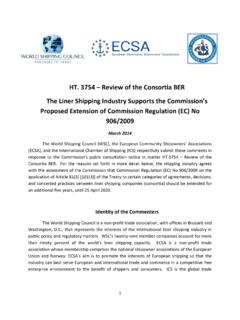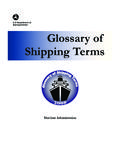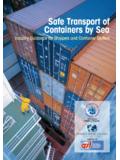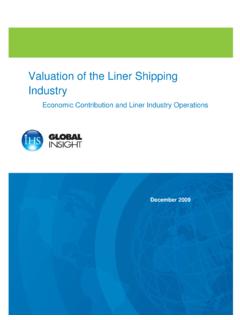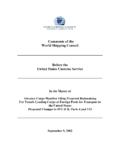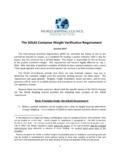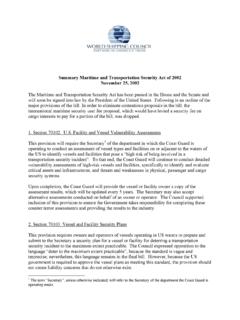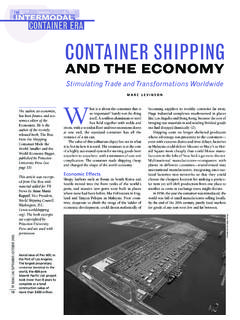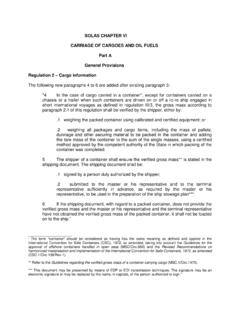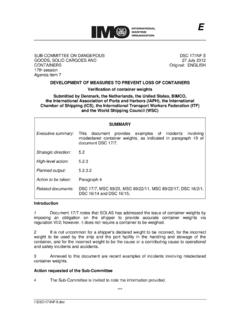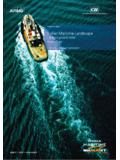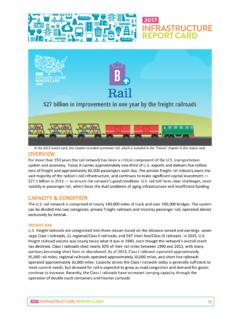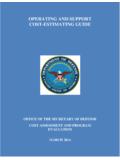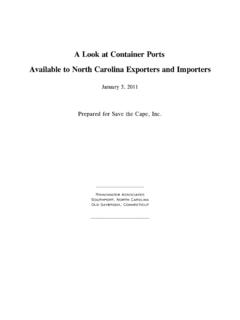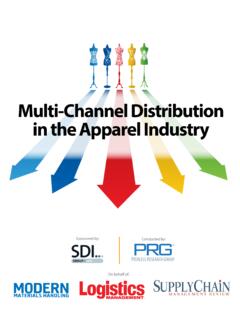Transcription of Some Observations on Port Congestion, Vessel Size and ...
1 1 some Observations on Port congestion , Vessel Size and Vessel Sharing Agreements Updated: July 6, 2015 Following labor disruptions on the West Coast in late 2014 and early 2015, as well as less dramatic port congestion issues in Europe and Asia, delays to containerized cargo movement and port congestion have been a subject of understandable interest. The efficiency of the international containerized cargo transportation system is an important economic issue, and there are many elements that affect the continued efficient flow of containerized cargo.
2 some recent discussions of port congestion have cited the increase in average Vessel size and the rise of multi-partner shipping alliances as causes of port congestion . The aim of this short paper is to support a fact driven analysis of the impact of Vessel size and alliances on port congestion . Port congestion can and does arise from multiple causes. Closer dialogue and joint problem solving is what is needed to address those issues, and solutions will not be found by pointing fingers.
3 Every participant in the supply chain will have a role to play. 1. Port congestion is a Multi-Faceted Issue Justifiable frustration over port congestion , especially on the West Coast, exists within all segments of the transportation community. Exporters, importers, ocean carriers, marine terminal operators, truckers, and railroads all experience additional costs when cargo and equipment does not move efficiently through the terminals and when there is congestion . Ocean carriers, port authorities, marine terminal operators and others are actively working to reduce congestion pressures.
4 Port congestion can arise from multiple causes, and those causes may vary by port or by marine terminal. These include: Labor productivity issues, as has been vividly demonstrated recently on the West Coast o During the West Coast labor difficulties, port productivity at some terminals fell by 73% from September 2014 to February 2015, delaying cargo and resulting in vessels waiting for a berth. 2 o Accountability for chassis inspection at West Coast ports under the new ILWU-PMA labor agreement is another controversy affecting the efficiency of port operations.
5 Unexpected surges in cargo volumes, as occurred in New York/New Jersey when carriers and shippers diverted cargo from West Coast ports dealing with labor difficulties to East Coast ports Inconsistent marine terminal productivity o The same Vessel may be served with more efficient terminal productivity in Asian ports than in ports . Poorer and/or inconsistent productivity levels have existed at ports /terminals for years. The efficiency of Vessel operators cargo stowage planning Vessel operators schedule reliability A terminal s ability to avoid berth congestion Inefficiency of the transportation infrastructure connecting a marine terminal to rail and roadways Disruptions to intermodal rail networks that serve ports The lack of on-dock rail capacity at some marine terminals.
6 Or the inability of more than one railroad to access an on-dock rail facility The amount of land that the port facility has to store containers and conduct operations, how wide and deep the container stacks are in the facility, and how many container moves are required to retrieve a container from a stack Shortages of various types of equipment ( , yard cranes, chassis, railcars, etc.) The recent transition in North America from reliance on ocean carriers providing container chassis to reliance on other parties to provide the chassis, as they do in other parts of the world.
7 Hours of marine terminal operation The time chosen by shippers or truckers to pick up their shipments Hours when warehouses or distribution centers are open to receive or discharge containers Weather, such as the bad 2014 winter weather affecting north Atlantic ports , and Whether there are efficient alternatives to storing empty containers within the port terminal facility. One carrier s efficiency in port can be affected by the actions of another ocean carrier using the same marine terminal.
8 congestion at a marine terminal gate may have nothing to do with whether an ocean carrier has a container prepared for shipper pick-up. some port congestion problems can be a result of a combination of factors, and most probably are. The above is hardly an exclusive or exhaustive list of reasons for port congestion , but it illustrates that the problem is not caused by a single or simple set of factors. These factors may vary by country, port and terminal, and they usually do. Resolution of the problems requires a 3 concerted set of actions involving all parties.
9 Those solutions will need to be tailored to the specific problems in specific locations. While larger ships do require operational adjustments from carriers and from port facilities, larger ships also handle commerce with more energy efficiency and with less environmental impact. The problems of port congestion cannot be accurately explained as simply a matter of the size of ships or Vessel sharing alliances. 2. Understanding Changes in Vessel Size The growth of large and ultra large vessels in the container industry has affected the Asia-Europe routes more than the Trans-Pacific and other trades.
10 The largest container ships (18,000 TEU +) are deployed only in the Asia-Europe trade. For example, the vessels in Maersk Line s Asia-Europe AE10 service increased from 8,500 TEU vessels in the second half of 2010 to 18,000 TEU in August 2013, while the vessels in its TP6 Trans Pacific service increased from 8,600 TEU to 9,400 TEU. Ships with a capacity in the range of 8,000+ TEU have called ports for a number of years. More recently, containerships of roughly 12,000 14,000 TEU size have begun calling at California ports .
